So you’ve got your boxwoods (buxus sempervirens) established in your lawn and you have great intentions for them. Before you rush out with a random set of shears and ideas about how to prune, there are some things you should know.
Pruning boxwood shrubs is an intricate process that, if done correctly, will add life, beauty, and function to your garden or lawn.
If you want to maintain the health of your plants, then you’ll also want to check out our guide on figuring out why your arborvitae are turning brown.

There are different tools that you can use to prune these plants. Each has its own function and purpose. We will help you choosing the right pruning equipment for your needs.
Aside from the tools, you will also learn the best time of year to cut back the newly grown limbs that have arisen from these slow-growing plants. Pruning too late in the year could cause you to lose the shrub altogether.
At the end of the article we will go into five steps you can take when you are trimming to ensure that your boxwood remains a healthy and beautiful piece of the landscape of your home or garden. Running out to the yard and haphazardly pruning branches is a bad idea.
Pruning these beautiful plants is essential not only to the plant’s function in your garden but also to the overall health and well-being of your bushes. Keep reading below to learn all the key points you need to be aware of before you begin pruning plants.

When to Trim
Boxwood shrubs are slow-growing plants. Because of this slow growth, gardening with these bushes requires relatively little maintenance. Generally speaking, you can maintain your bushes by pruning once a year.
Once established, the best time to trim is in the spring. You can also shape and touch up your bushes through mid-summer if you find it necessary.
Avoid pruning or shaping in your gardens in late summer or early fall. Pruning during this time of year will not allow the new limbs to harden before the coming winter. The new growth is pliable and tender and needs the time for the new branches to harden before the cold.
You should never prune in the winter.
If you plan on creating topiary pieces or you are pruning to shape and rejuvenate the plant, the best time is late spring to early summer. This will give the new growth plenty of time to heal before the winter cold.
The exception to this rule is if you find diseased or dead branches within the bush. These should be removed immediately from the base of the plant so that the living shrub surrounding it will not be subject to disease.

Recommended Equipment
Whether you are using these plants to form a hedge or as a topiary piece, you should have the right equipment for the job. These bushes may grow as high as 10′ and as wide as 6′. Different plant dimensions and different shrub functions require different sets of tools. Here is a list of the tools you may choose to use for your gardening needs.
Bypass Pruning Shears
This is the most popular type of handheld shear. They have a stainless steel blade that cuts with a scissor-like action. The hook, or the lower cutting surface, provides leverage for the sharpened edge to cut the branch. The hook will pin the branch against the blade and allow for a neat and clean cut.
These are effective for branches up to ¾” in diameter. Generally, bypass pruning shears are used to cut back areas of the plant that are still living as the cut does not damage the plant and allows it to heal correctly.

Anvil Pruning Shears
These shears are also handheld, but operate a bit differently than the bypass pruning shear.
This type of shear uses a single blade that closes down against the anvil. The anvil is simply a flattened edge that provides leverage for the blade to work against. If this is hard to picture, think of using a knife and a cutting board.
These tend to be a bit larger and less precise than the bypass pruning shear. As such, they are more difficult for precise cuts in tighter spaces. They are also effective for limbs up to ¾” in diameter.
If you have diseased or dying boxwood where many large branches will need to be prune, anvil shears are an ideal choice.
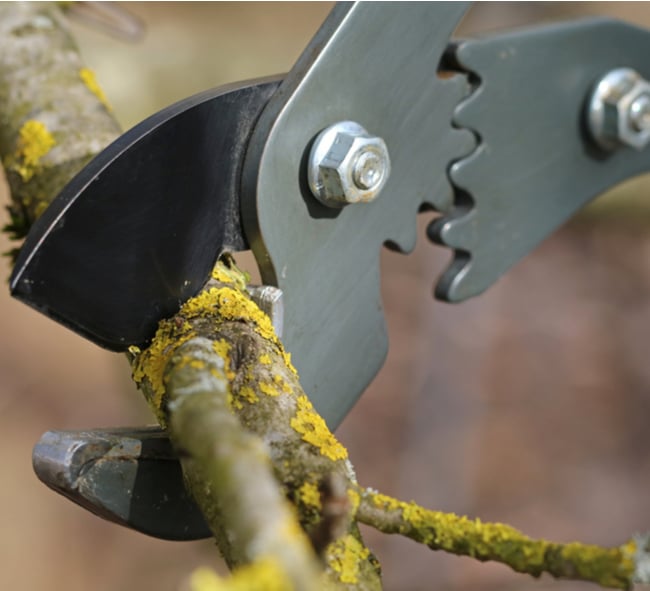
Loppers
Loppers have long handles that allow you to reach taller areas.
Because the handles are longer, you will have significantly more leverage when you decide to prune the larger branches. The added power is used to cut the limbs that are greater than ¾” in diameter.
Loppers come in both bypass and anvil cutting styles.
The extended handles make this tool bulkier than the smaller shears and are not typically used for precise or shaping cuts.
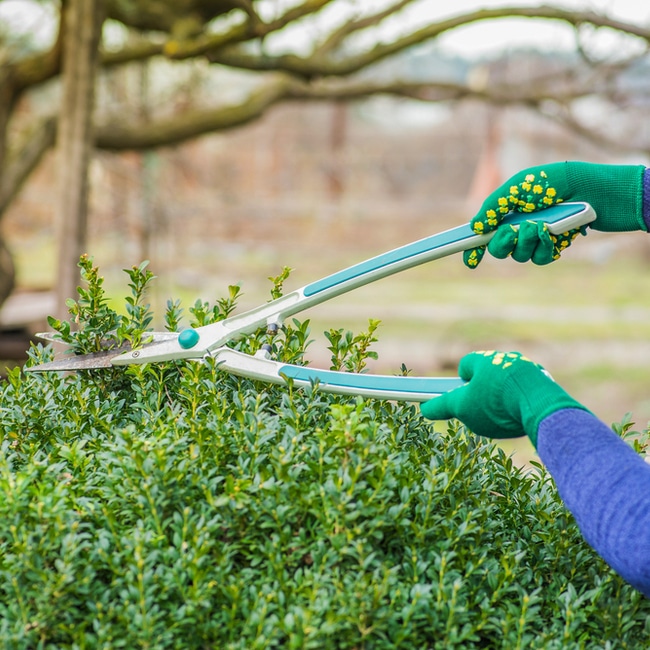
Hedge Trimmers
Hedge trimmers are gas, electric, or battery-powered tools that have long oscillating blades. The long blades allow you to prune wide swaths of the small branches with a single stroke.
Hedge trimmers are ideal when shaping larger boxwoods. With good power and sharp blades, you can shape your bush into nearly any shape you can imagine.
The blades on a hedge trimmer can be as long as 24″ and can cut branches as thick as ¾.” Be careful when using this type of equipment because it can cut such a large area at one time. Cutting back too much is detrimental to the bush’s overall health and vitality in your garden.

Step-by-Step Guide
Once you’ve chosen the right tools for the job, there are 5 steps you should take when you go out to prune.
1. Remove Dead or Diseased Branches
Before you begin, you need to inspect each boxwood on its interior and exterior for dead and diseased limbs. These should be relatively easy to see when compared against the otherwise healthy backdrop of the bush. Make sure to cut these dead or diseased limbs at the base of the bush.
2. Check the Interior
Next, you need to open up the shrub and clean up any remaining leaves and other debris that may have fallen into the interior. Removing this debris will open up the airflow to the plant’s interior that is vital to its overall health.
3. Thin It
Inspect the for limbs that have overgrown the others and are beginning to take over the boxwood. You should cut these overgrown limbs back to the primary branch.
This will assist in providing airflow and allowing light to enter the interior of the plant. Doing this in spring will ensure that your entire plant remains healthy and vibrant for the remainder of the year.
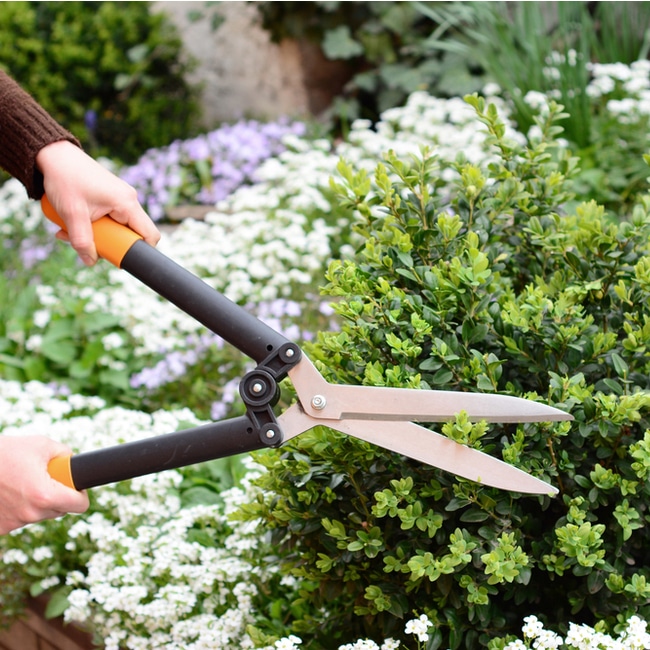
4. Shape It
This is the step where any topiary designs or intricate shaping will come into play. Prune the boxwoods around your homes and gardens back into the desired form to match your preferred aesthetics.
Use your imagination. Gardening with these plants can be an adventure because they are well suited to being trimmed. Whether your gardens are planted with bushes en masse or as single specimens, this is where precision comes into play.
5. Trim the Whole Boxwood
It is essential to make sure that you trim the boxwood in its entirety and not just the readily visible portions. This is crucial to the overall health and beauty of the plant.
By making sure that the entire bush is maintained, you ensure the vitality of the plant for many years to come. If you were to ignore the areas that are not easily seen, you run the risk of massive overgrowth and make the plant more susceptible to disease.
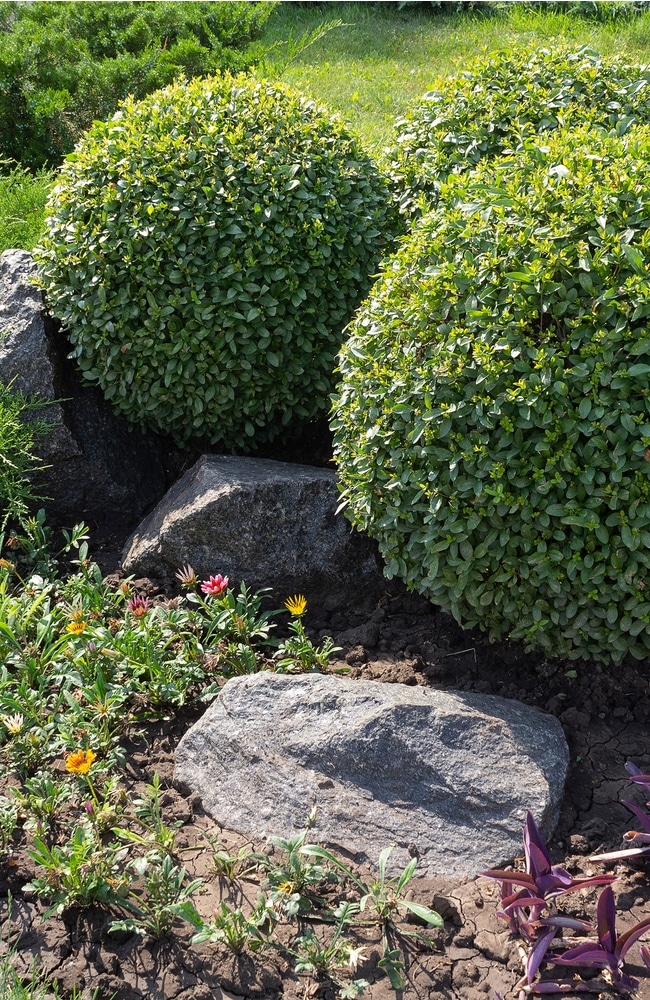

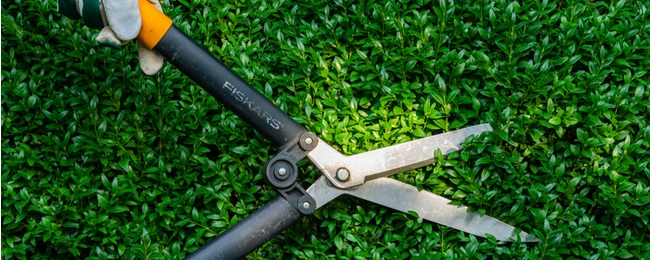
Very interesting and helpful, but my hedge is approximately 5 ft tall and I would like to take it down to 3 feet. How do I do that and not kill the hedge?
That’s problem as well. I killed a section last year and I didn’t cut much off.
Per above instructions it looks as though trimming that amount should be done over time
I just had my home renovated from a tornado.
the scaffolding caused all my small box woods to lean over forward in my beds.
I was trimming them across the front and on top. The top looks great but
the front is left with little to no green. Will this fill in green in the Texas heat or
have I ruined them?
It is hard to say, only time will tell how much damage was done to the roots when they were leaning forwards.
I had to cut away a full 1/4 of a dead side of one of my boxwoods here in Tennessee, which left a big gaping hole. But it filled in nicely after about three seasons. If you’re currently bare sections don’t green up this season, I would suggest cutting away those branches altogether so that new growth can fill in eventually.
My biggest are now 6’ tall and almost 4’ around. I want them much smaller- what do I do and when? Don’t want to kill them. I’ve been trimming them slightly back for 26 years now, and they unfortunately only have a surface layer of leaves.